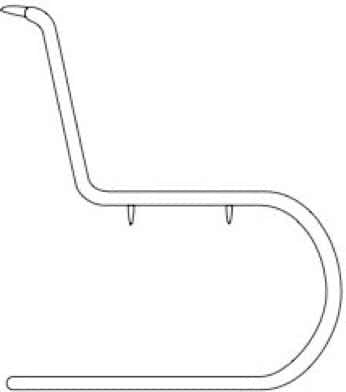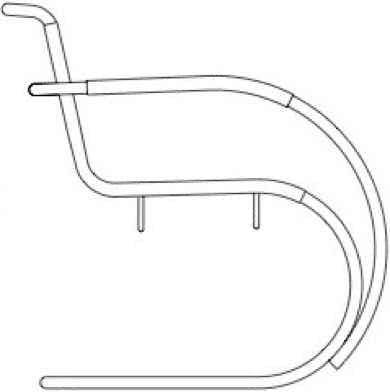Ludwig Mies van der Rohe discovered the principle of the cantilever chair, with no back legs, thanks to Mart Stam. But it was he who was the first to give it all its elegance, making full use of its aesthetic lightness and dynamic lines.
Despite the novelty of the concept, Mart Stam's first chairs did not appeal to Mies van der Rohe, who transformed this technological innovation into a new aesthetic proposition: it was the S533 chair, which he presented in 1927, and whose large elegant arc drawn by the tubular steel frame seems to take over the space surrounding it.
Consciously reduced materials, elegant lines and transparent effects - these are the main features of the S533 chair. Its permanent springing effect also makes it particularly comfortable.
While most designs in the 1920s were simple and functional, the architect's signature is clearly evident here: Mies van der Rohe's resolutely luxurious concept combines functionality, comfort and a timeless aesthetic. The S533 chair is the emblem of a new perception of quality.
S533 Chair – Natural cane
S533 F Chair – Natural Cane
S533 Chair – Black full-grain leather – lacing on seat and back
S533 F Chair – Black full-grain leather – stitched seat and back
S533 Chair – Silver synthetic fibre
S533 F Chair – Silver synthetic fibre

S533 Chair – Leather
from
S533 Chair – Synthetic fibre
from

S533 F Chair – Leather
from
S533 F Chair – Synthetic fibre
from
Black felt glides
Transparent felt glides
Black plastic glides
Transparent plastic glides
Ludwig Mies van der Rohe
Ludwig Mies van der Rohe, born in Aachen in 1886, joined Peter Behrens's architectural practice at the age of 22, where he met Walter Gropius and Le Corbusier. Mies van der Rohe soon became a leading figure in the new glass and steel architecture of the time. His design for a glass and steel tower on the Bahnhof Friedrichstrasse in Berlin was decisive. From 1925, he was responsible for the artistic direction of the Deutscher Werkbund. In 1927, the Weissenhof estate in Stuttgart was created under his direction. In 1930, Walter Gropius appointed Mies van der Rohe as director of the Bauhaus, which he had to close on 10 August 1933 under pressure from the NSDAP. He then emigrated to the United States. In 1938, he moved to Chicago, where he became head of the architecture department at the Armour Institute. He became one of the world's most influential architects. His steel-framed buildings with large glass curtain walls, such as the Seagram Building in New York (1958) and the National Gallery in Berlin (1968), are among the jewels of modern architecture. The design of his furniture generally evolved in relation to his buildings. Ludwig Mies van der Rohe died in 1969 in Chicago.
Garantie Prix
Proposer du design au juste prix fait partie intégrante de notre travail. Si vous trouvez le même article à un prix inférieur chez un autre revendeur, livraison incluse, non seulement nous l'égalerons, mais nous vous proposerons même un meilleur prix.
Comment en profiter ?
Nous comparons chaque jour nos prix avec tous les détaillants autorisés en Europe. Si néanmoins vous trouvez moins cher, contactez-nous pour une contre-proposition.
Nous devons être en mesure de vérifier que l'article est authentique, neuf, parfaitement identique (taille, matériaux, couleur, etc.) et qu'il ne fait pas partie d'une campagne ou d’un déstockage temporaire.
La base valide est, par exemple, un devis actuel ou un lien direct vers le site Web d'un autre détaillant où le prix inférieur est indiqué. Une image d’e-mail n'est pas valide, l'e-mail d'origine doit être transféré.
L’offre ne s'applique pas aux commandes déjà passées et ne peut être couplée à aucune de nos autres offres ou promotions.
Price Guarantee
Offering design at the right price is an integral part of our work. If you find the same item at a lower price at another retailer, delivery included, we will not only match it, but even offer you a better price.
How to take advantage of it?
We compare our prices every day with all authorized retailers in Europe. If nevertheless you find cheaper, contact us for a counter-proposal.
We must be able to verify that the item is authentic, new, perfectly identical (size, materials, color, etc.)
and that it is not part of a campaign or temporary destocking.
The valid basis is, for example, a current quote or a direct link to another retailer's website where the lower price is indicated. An email image is invalid, the original email must be forwarded.
The offer does not apply to orders already placed and cannot be combined with any of our other offers or promotions.